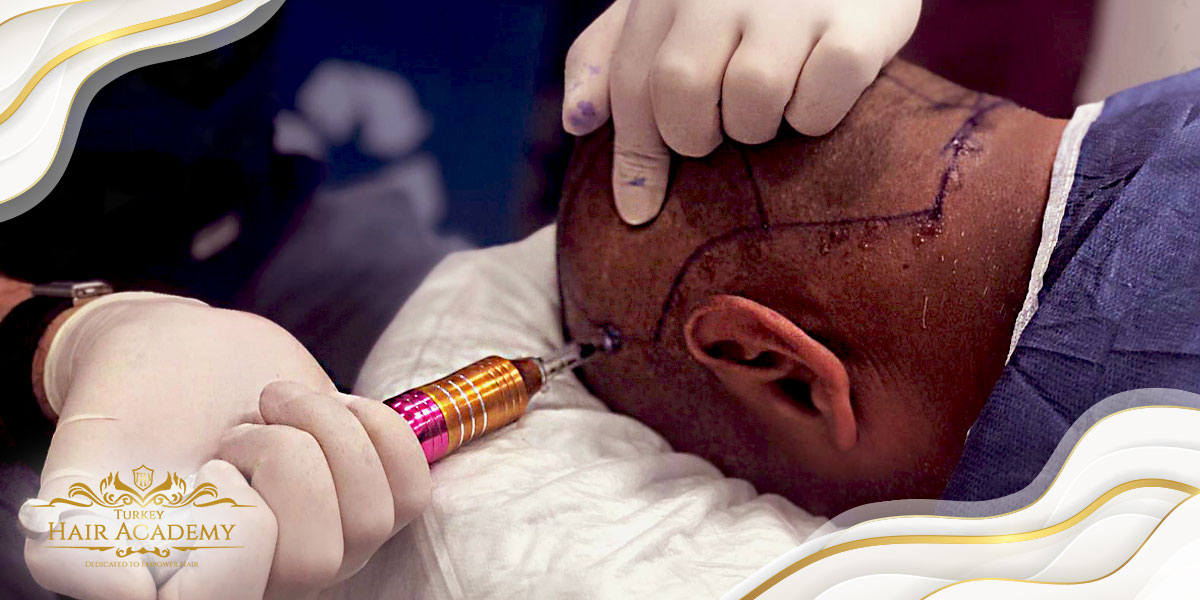The anesthesia methods used during hair transplantation are crucial to ensure patient comfort and minimize pain during the procedure. Today’s medical technology allows patients to undergo this procedure as if it were a simple operation. Hair transplantation is usually performed under local anesthesia, but sedation can also be used for the patient’s benefit.
Local anesthesia is used to relieve pain in the areas where the procedure will take place and to create a comfortable environment for the patient. It is used during hair follicle harvesting and transplantation. First, it is applied to the area where the hair follicles will be collected, and the sensation of pain is lost. Once the grafts are collected in the area, it is applied to the area where the transplantation will take place, and the pain sensation is lost to start the procedure.
For the administration of drugs, 4 mm long hypodermic needles are used, which cause little discomfort when penetrating the skin.
Hair transplantation under sedation is a method used when a person wants a hair transplant but is afraid of needles or surgery. It is also used for people with heart and blood pressure problems. After the hair transplant is performed under sedation, the patient falls into a light sleep during the procedure. In this way, the patient does not feel any anxiety during the procedure and the team performing the hair transplant can work comfortably.
General anesthesia is rarely used and only in special cases. It may be used if the patient is very anxious and stressed for some reason. However, since the patient is under anesthesia for a long time and loses consciousness, it is generally not recommended for hair transplants. It can bring many risk factors during the procedure. Therefore, it is important that both the patient and the surgeon weigh whether or not to use anesthesia.

Contents
What Is the Sedation Hair Transplant Process?
The patient is examined by an anesthesiologist to determine if they are suitable for sedation. Then, the patient is administered a combination of relaxing and pain-relieving medications through a IV. Once the medication takes effect, the person enters a sleep-like state with consciousness still intact. Local anesthetic needles are then placed in the head area. With the help of local anesthesia, the hair transplant area becomes numb and the most appropriate hair transplant technique is applied based on the consultations conducted with the patient.
Hair Transplantation Procedure and Post-Anesthesia Process
After the hair transplant procedure, the patient begins the healing process as soon as the effect of anesthesia wears off. After the procedure, the patient may experience numbness in the scalp for a few days. The numbness and other discomfort will subside over time. Although this varies from person to person, the numbness usually goes away on its own within 24 hours. Depending on how sensitive one’s body is to anesthesia, the effects of the anesthetic may last for a longer period of time in some people. In this case, it is important that you remain in contact with your doctor without worry.
Any pain felt during this process can be easily controlled. It is recommended that you start using the pain relievers prescribed by your doctor on a regular basis. The patient can return to his daily life shortly after the hair transplant. It is important to follow the doctor’s specific care recommendations to protect the transplanted hair and reduce the risk of infection.
Post-Anesthesia Recommendations for Hair Transplantation
- Be sure to rest for the first few hours after anesthesia. This will help reduce pain and discomfort in the areas treated with anesthesia.
- Avoid applying pressure to the head if there is numbness due to the anesthesia.
- Avoid any contact with the hair transplant area if you experience itching or tingling as a side effect.
- Perform exercises such as deep breathing to shorten the time it takes you to return to normal after anesthesia.
- Drink plenty of water and pay attention to your sitting and sleeping position.
You can trust the doctors at Turkey Hair Academy to perform your hair transplant with serenity. For more information, please contact us.


